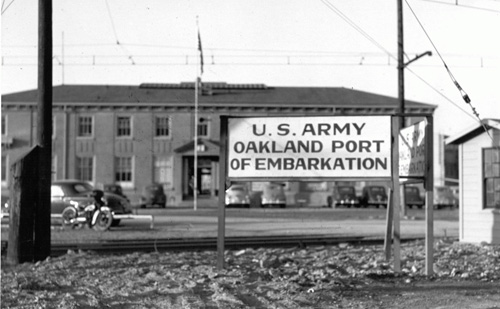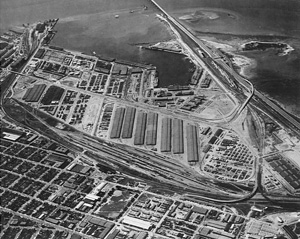About the project

The OAB was recommended for closure by the Base Realignment and Closure Commission in 1995 and finally shut its doors in September 1999. Ownership of the base was transferred to the City of Oakland (City) and to the Port of Oakland (Port) in 2006. Parts of the OAB were determined eligible for listing in the National Register of Historic Places (NRHP) as a discontiguous historic district. Redevelopment of the OAB by the City and the Port would remove all resources contributing to the OAB Historic District rendering it no longer eligible for the NRHP. The loss of the OAB Historic District was determined a significant impact by the Oakland Army Base Area Redevelopment Plan Environmental Impact Report (EIR), which identified mitigation measures to partially compensate for the loss. The Oakland Army Base Oral History Project implements recommended cultural resources mitigation measures from the Final EIR. The City and the Port jointly fund this project.
This oral history project on the OAB is intended, first and foremost, to capture living memories of a now closed institution. Beyond the basic act of recovering memories, however, the project seeks to gain information about: the core functions of the base as part of the Port of Embarkation, as headquarters for the Military Traffic Management Command, Western Area, and as a key element of the Port of Oakland, one of the largest deep-water ports in the United States; the social, cultural, and military life on the base as it relates to a wide variety of issues including labor, housing, politics, public order, and the environment; and the relationship between the OAB and the surrounding world, from immediate community of West Oakland to the City and Port of Oakland to the rest of the world.
The OAB Oral History Project is designed to last three years. During the first two years of the project, approximately 45 interviews shall be conducted on the topics mentioned above with veterans, former base employees, community members, and policy makers. The interviews are transcribed, reviewed by the interviewees, and then posted on this website (the Regional Oral History Office is in compliance with the UC Berkeley Committee for the Protection of Human Subjects.) The final year of the project will be devoted to creating a book about the OAB based primarily upon the oral history interviews.
Project team (2007-2009)
Martin Meeker, Project Director and Interviewer
Vic Geraci, Associate Director of ROHO
Lisa Rubens, Interviewer
Ann Lage, Interviewer
Robin Li, Interviewer
Jess Rigelhaupt, Interviewer
Julie Allen, Production Coordinator
David Dunham, Web/Video Editor
Funding
The Oakland Army Base Oral history project is funded through a contract with the Port of Oakland and the City of Oakland for the duration of three years.
Statement of Scholarly Independence
Although funded by the Port of Oakland and the City of Oakland, this project was planned and is being executed as an independent scholarly research project; individual interviewees are covered by UC Berkeley Committee for the Protection of Human Subjects guidelines that provide for sealing portions of interview transcripts at the discretion of the interviewee. While the research design and interviewing are independent of the Port and the City, we have been assisted by staff at both institutions in identifying research themes and in selecting and locating potential interviewees.
Project resources
Thematic focus
 We propose to select interviewees and conduct interviews with an eye to addressing three overarching themes, each of which contain a number of research questions and subthemes:
We propose to select interviewees and conduct interviews with an eye to addressing three overarching themes, each of which contain a number of research questions and subthemes:
- Core Base Functions: By focusing on “core base functions” we intent to explore the raison d’etre of the OARB: its role as the point on embarkation for supplies, weapons, and troops. We propose to examine the following issues:
- Technology and labor: the sixty years from the beginning of the Second World War to the decommissioning of the OARB witnessed vast changes in the use of technology and labor for supplying the military. We will explore the nature of these changes and how they played out on the piers and in the warehouses of the base.
- Military objectives and tasks: Work on the base varied greatly from wartime to peacetime, and from one era to the next. We will explore the relationship between the context of worldwide and hemispheric military engagements and the kind of work accomplished on the base.
- Military and capital/trade: Presuming there is a close relationship between U.S. military action and the opening (or closing) of foreign markets to U.S. commerce, we will explore the role played by the OARB in the management of this relationship in both larger global matters but also developments closer to home, such as the military command of the Port in WWII and the gradual transfer of base land to the port in the 1990s.
- Transportation networks: As a port of embarkation, the OARB served as a hub, linking two great transportation networks: road and rail on the land and ships at sea. Interviews will explore not only what (and who) traversed those networks, but will examine how those networks changed along with the ramifications of those changes, such as the emergence of intermodal transport.
- City within a City: With a varying population that, at times, reached the tens of thousands, the OARB was a city within a city. We propose to explore the internal life of the army base by focusing on:
- Community and cultural life: For residents of and contractors working at the OARB, the base provided not only the necessities of life (food and shelter), but also made an effort to sustain community and culture. Interviews will explore all facets of cultural life, including: religion (individual and communal experiences), entertainment (movies, dances, concerts), athletics (baseball, bowling), sociability (clubs, bars, mess halls), and foodways (from MREs to the officer’s dining hall).
- Governance and Order: Like any city, the base required a local structure of governance to maintain working order (sewers, water, power), including policing apparatus to keep public order. We will examine the ‘local’ governance structure with an eye to explaining how the various arms of it accomplished their assigned tasks; interviews will examine how base life facilitated order but also incidents when it was undermined.
- Housing, health, and well-being: Public health and housing take on new meanings when the site under consideration is a military base, where the federal government is obliged to provide all the basic needs of its residents. Interviews will explore the military-model of housing and health provision. We will also examine the place of families, children, and schooling on the base.
- Military and social hierarchies: Hierarchical to its core, military order and function derives from and is integral to its structure. Interviews will explore the ways in which hierarchies of rank were mobilized to serve the mission of the OARB, but also instances in which rank hierarchies were questioned. We also will examine historically variable hierarchies of race, class, gender, and sexuality at the base across all project themes.
- Community Impact: Being a city within a city, the OARB was compelled to interact with surrounding communities, cities, and regions as part of its mission. We propose to explore the impact of the OARB on the surrounding communities, and vice versa, by focusing on the following issues and questions:
- City of Oakland and Alameda County governance: Because of state and federal precedence, city bureaucrats and elected officials find the governing of municipalities difficult. This is compounded when a massive federal institution sits immediately adjacent to the city in question. Although many cities compete for new military bases, others lament the difficulties caused by those already present. Located in a large urban area, the OARB was an integral part of the patterns of everyday life and the eruptions of sensational events that make up the history of the San Francisco Bay Area since the beginning of World War II. Interviews will explore the ways in which local government dealt with the OARB and vice versa.
- Public order and policing: One of the most important, and troubling, arenas of base - community interaction came with policing and public order. Interviews will explore how several difference policing forces (Oakland Police Department, Alameda County Sheriff, base MPs, Shore Patrol, Armed Forces Disciplinary Control Board) addressed issues related to soldier behavior (e.g. AWOLs, public drunkenness, rape), vice (prostitution, gambling, drugs), etc.
- Politics and protest: As an outpost for both the military and federal government, the OARB was a lightening rod for community pride and protest. Interviews will examine instances in which the surrounding community looked to the base as a national pride (e.g. VJ day, Memorial Days) and as a source of national shame (i.e. during the Vietnam War and the anti-nuclear movement).
- Community outreach and crisis mitigation: Beyond the obvious times of stress during protests, the OARB and the surrounding community (particularly of West Oakland) had to maintain a stable working atmosphere. Interviews will explore the mechanisms, protocols, and organizations established to facilitate constant contact between the base and the surrounding communities.
- Environment: Perhaps the most profound and longest-lasting impact the base has had (and will continue to have) on the surrounding communities comes in terms of its environmental impact. Interviews will explore how the OARB impacted the local environment from landfill programs to oil spills to cleanups following decommissioning.
- OARB and Port of Oakland relations: Sharing the same waterfront and engaging in the same larger project of producing wealth from the nation, the OARB and the Port of Oakland still were two very different entities who had to work together closely over the entire period of this study. We will explore the larger issues as well as the intricacies of this relationship.
Oakland Army Base book
To your reserve your copy of the Oakland Army Base book, please send your name, address, email, and phone number to Paul Burnett with ‘OAB Book’ in the subject line.
- Excerpt: CHAPTER 3: The Oakland Army Base and the American Dream
- Read Oakland Tribune Article on Oakland Army Base Oral History Project Book.
- Read UCB article: “Oral history weaves story of the Oakland Army Base and its profound region-wide impact.”